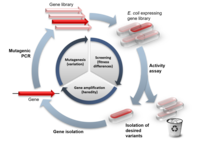
Photo from wikipedia
Modern fishes represent over 400 million years of evolutionary processes that, in many cases, resulted in selection for phenotypes with particular performance advantages. While this certainly occurred without a trajectory… Click to show full abstract
Modern fishes represent over 400 million years of evolutionary processes that, in many cases, resulted in selection for phenotypes with particular performance advantages. While this certainly occurred without a trajectory for optimization, it cannot be denied that some morphologies allow organisms to be more effective than others at tasks like evading predation, securing food, and ultimately passing on their genes. In this way, evolution generates a series of iterative prototypes with varying but measurable success in accomplishing objectives. Therefore, careful analysis of fundamental properties underlying biological phenomena allow us to fast-track development of bioinspired technologies aiming to accomplish similar objectives. At the same time, bioinspired designs can be a way to explore evolutionary processes, by better understanding the performance space within which a given morphology operates. Through strong interdisciplinary collaborations, we can develop novel bioinspired technologies that not only excel as robotic devices but that teach us something about biology and the rules of life in the process.
Journal Title: Integrative and comparative biology
Year Published: 2022
Link to full text (if available)
Share on Social Media: Sign Up to like & get
recommendations!